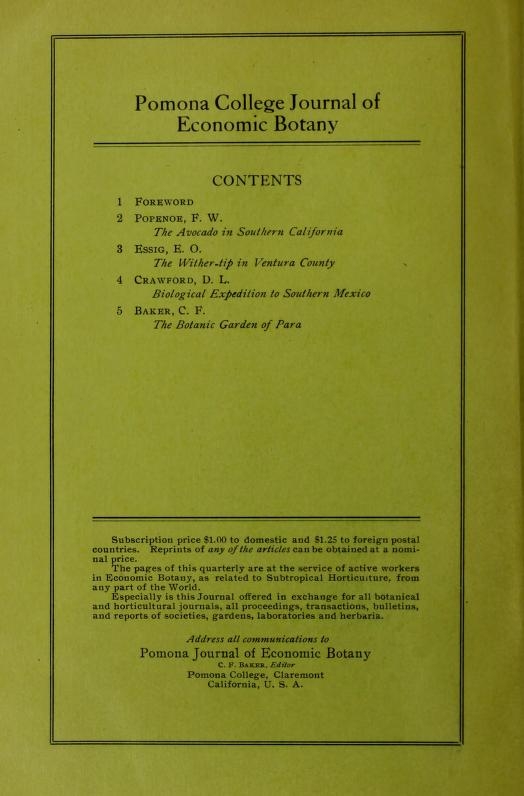
Posts Tagged: citrus disease
Cultural Practices to Reduce Pest and Disease in Avocado & Citrus
In many ways our pest and disease management of fruit tree crops are exacerbated by our cultural practices. Avocado and citrus offer some very clear demonstrations of how we manage our trees can lead to reduced pesticide use. From the beginning, our selection of rootstock and scion can help lessen pest and disease problems. In both avocado and citrus we have good rootstocks which can handle problems, such as root rot more effectively than seedling rootstocks. So it is imperative that if you know that drainage will be a problem, starting off with the right, healthy rootstock helps. Also scion selection can have a major impact, as well. For example, ‘Lamb' avocado is much less prone to persea mite than is ‘Hass'. This pest can significantly impact a spray program and planting ‘Lamb' could mean virtually no sprays for this pest. Selling the ‘Lamb' fruit is then the challenge There are similar examples in citrus where one variety is more prone to a pest or disease than another.
Irrigation is probably the most important cultural factor in managing tree disease. Over, under and improperly timed irrigations are the conditions necessary for many root diseases. The Phytophthora spp. fungi are looking for distressed root systems brought on by waterlogging and other stressful situations. Other conditions, such as wetted trunks can also bring on some trunk diseases, like gummosis in citrus and crown rot in avocado. Simply preventing irrigation water on the trunks can limit these diseases. Other diseases, such as black streak, stem blight and bacterial canker in avocado are bought on by soil moisture stress.
Nutrients, especially nitrogen management, has been long known to affect levels of insects, such as scale, mealy bug and aphid. Encouraging lush growth helps sustain these insects, so reducing this growth tends to lower their numbers. Managing when canopy growth occurs can affect pest severity. Avocado thrips build their populations in the spring and moves easily from leaf to fruit causing significant scarring. By promoting leaf growth at flowering time with a nitrogen application, keeps the insect on the leaves and reduces fruit scarring. This also promotes growth that replaces leaves that have been damaged by persea mite. Likewise the incidence of citrus leaf miner damage can be reduced if spring pruning is avoided so that a flush of growth does not occur at the same time as the population is building. Timing of pruning is important in lemons to avoid wet periods of rain and fog to reduce the spread of hyphoderma wood rot fungus when its fruiting bodies are active.
Pruning can change pest pressure by changing the humidity in the canopy, introducing light and changing the climate supporting disease and pests. By making spray coverage more thorough, it also makes for a more effective application. Modified skirt pruning can have significant effects on mealy bug and scale control, fuller rose weevil incidence, ant colonization and snail damage. It's important that the trunk be protected as an avenue of movement for snail and ant control to get the best effects of this pruning. Skirt pruning also reduces problems with such weeds as bladder pod and the ladder effect of brown rot in citrus – fungal propagules splashed from the ground onto low-hanging fruit, which in turn is splashed to higher fruit.
Keeping a canopy clean of dust and fire ash also makes for more efficient biological control. Because predators are slowed in their search, they are less efficient. They also spend more time grooming their sensory organs, and this also slows them down. Parasites such as wasps are actually slowed by the physical abrasion to their tarsi. Dust also creates a drier environment, which is more hospitable to our pest mites. Watering picking rows, roads and even the trees themselves can lessen mite populations. Use of cover crops can also reduce dust and potentially provide pollen and nectar for predators and parasites. Of course cover crops create a whole new set of management issues, such as colder winter orchards and snails.
Finally harvest timing to avoid pest and disease is often overlooked. In avocado, fruit is often set in clusters. Greenhouse thrips love the microclimate created, and if in a size-pick the cluster is reduced, greenhouse thrips will often not be a problem. Harvest timing is also important in citrus. Fruit left too long on the tree can often develop septoria fungal spot. Picking in a timely manner reduces the incidence of this disease.
These are just a few examples of how cultural practices at the right time can reduce pest and disease problems.

avocado pruning
Five Snail Speakers for the Price of One
Snails and Slugs (May 22, 2019 from 3-4pm)
Presenters: (!) Dr. Cheryl Wilen (UC IPM), (2) Dr. Rory Mc Donnell and (3) Dr. Dee Denver (Oregon State University), (4) Dr. Adler Dillman and (5) Dr. Irma De Ley (UC Riverside). The webinar will cover an overview of snail and slug biology, damage and management with emphasis on brown snail and Italian white snail, and current research on slug biocontrol using nematodes. One DPR CE unit (other) and one CCA CE unit (IPM) are approved.
And What Else Are the
UC Ag Experts
Talking About? 

| Event Name | Date |
|---|---|
| UC Ag Experts Talk: Snails and slugs | 5/22/2019 |
| Uc Ag Experts Talk: Management of Weeds in Citrus Orchards | 6/19/2019 |
| UC Ag Experts Talk: Citrus Dry Root Rot | 7/24/2019 |
What is involved in the webinars?
A series of 1 hour webinars, designed for growers and Pest Control Advisors, will highlight various pest management and horticultural topics for citrus and avocados. During each session, a UC Expert on the subject will make a presentation and entertain write-in questions via chat during and/or after the presentation. As we develop this program, we may expand to other crops.
Topics: pests and diseases of citrus, avocado and other crops
And Next up is:
Management of Weeds in Citrus Orchards (June 19, 2019 from 3-4pm)
Dr. Travis Bean, assistant weed science specialist in UCCE, will discuss the importance of weed management in citrus, tree age and variety considerations, scouting and weed identification, cultural and mechanical practices, and pre- and post-emergence herbicides. One DPR CE unit (other) and one CCA CE unit (IPM) are pending.
Register in advance for the webinars by clicking on the event links above.
Are there Continuing Education units?
When the subject discusses pest or disease management, continuing education units will be requested from DPR (1 unit per session). Participants will pre-register, participate in the webinar and be awarded the unit. The sessions will be recorded and hosted on this web site for future study. However, continuing education units will be awarded only to the participants who attend the live version of the webinar.
Who is involved?
This webinar series is brought to you by Ben Faber (UC ANR Ventura Advisor) and Dr. Beth Grafton-Cardwell (Depart of Entomology UC Riverside Extension Specialist) with the technical support of Petr Kosina (UC IPM Contect Development Supervisor) and Cheryl Reynolds (UC IPM Interactive Learning Developer).
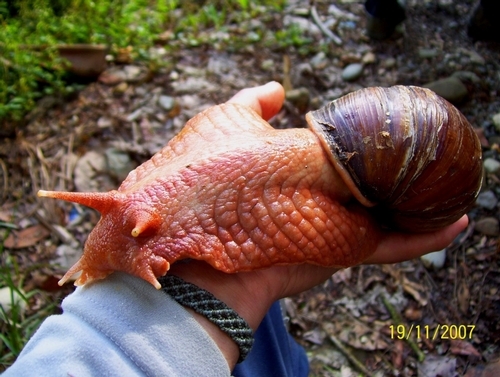
giant land snail
Avocado in Southern California - 1911
In 1911, the avocado was a relatively new crop in Southern California and the great USDA plant explorer Wilson Popenoe (pronounced POP e Noe according to Jack Shepherd), describes avocado culture and its problems
https://www.biodiversitylibrary.org/item/137628#page/31/mode/thumb
This is from the first volume ever of the Pomona Journal of Economic Botany which also has a nice description of "wither tip" of citrus in Santa Paula.
https://www.biodiversitylibrary.org/item/137628#page/5/mode/1up
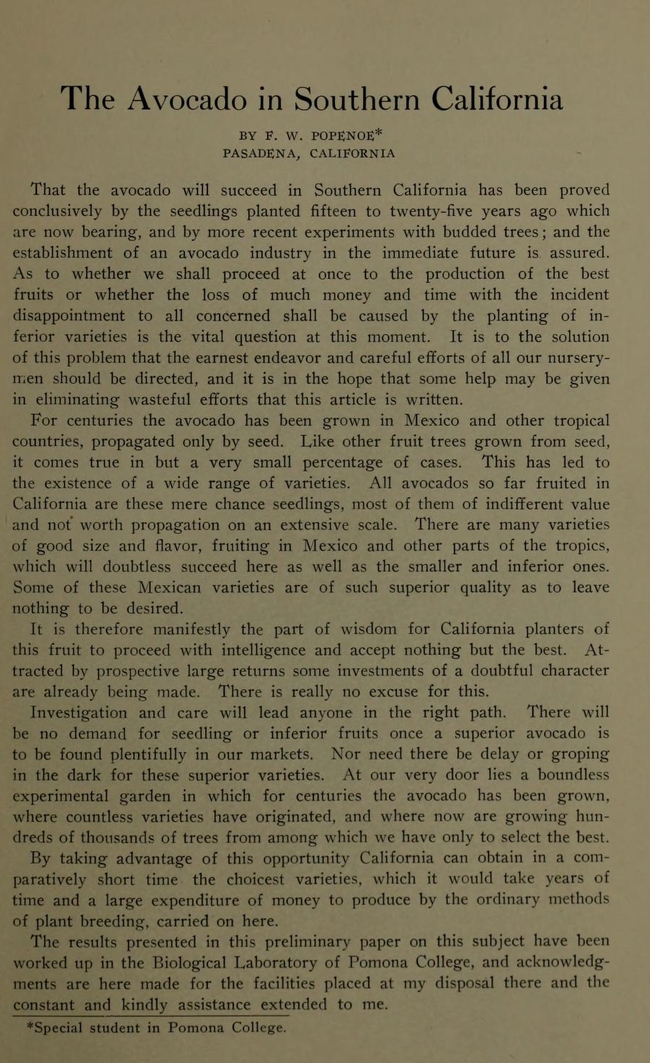
Cover Avocado in Southern California - Wilson Popenoe
Credit Worthy Webinars - Citrus/Avocado Pests and Diseases
What Are the Ag Experts Talking About?
| Event Name | Date |
|---|---|
| UC Ag Expert talks about citrus thrips | 10/17/2018 |
What is involved in the webinars?
A series of 1 hour webinars will highlight various pest management and horticultural topics for citrus and avocados. During each session, a UC Expert on the subject will make a presentation and entertain write-in questions via chat during and/or after the presentation. As we develop this program, we may expand to other crops. These programs are open to all, but are geared to those individuals, such as PCAs and Growers who need CEUs.
Topics: pests and diseases of citrus and avocados
What are the topics and how do I register?
Citrus Thrips - October 17, 2018 at 3 pm
Register in advance for this webinar by clicking on the event link above.
Are there Continuing Education units?
When the subject discusses pest or disease management, continuing education units will be requested from DPR (1 unit per session). Participants will pre-register, participate in the webinar and be awarded the unit. The sessions will be recorded and hosted on this web site for future study. However, continuing education units will be awarded only to the participants who attend the live version of the webinar.
Who is involved?
This webinar series is brought to you by Ben Faber (UC ANR Ventura Advisor) and Dr. Beth Grafton-Cardwell (Depart of Entomology UC Riverside Extension Specialist) with the technical support of Petr Kosina (UC IPM Contect Development Supervisor) and Cheryl Reynolds (UC IPM Interactive Learning Developer).
https://ucanr.edu/sites/ucexpertstalk/
Photo: The mighty citrusthrips - Scirtothrips citri
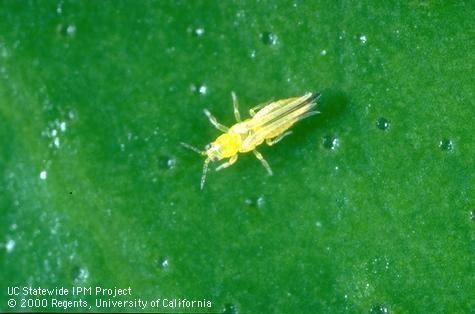
citrus thrips
Citrus Brown Rot Lookout
No rain for several years may have let citrus growers think that brown rot control is not important. But it still is and it's just coming out after a few inches of rain earlier this January. This is not the brown rot of stone fruits caused by Monilina fungus but a pathogen, completely different – Phytophthora spp.
Symptoms appear primarily on mature or nearly mature fruit. Initially, the firm, leathery lesions sometimes have a water-soaked appearance. Lesions are tan to olive brown, have a pungent odor, and may turn soft from secondary infections. Infected fruit eventually drop. Occasionally, twigs, leaves, and blossoms are infected, turning brown and dying.
Brown rot is caused by multiple species of Phytophthora when conditions are cool and wet. Brown rot develops mainly on fruit growing near the ground when Phytophthora spores from the soil are splashed onto the tree skirts during rainstorms; infections develop under continued wet conditions. Fruit in the early stage of the disease may go unnoticed at harvest and infect other fruit during storage.
Brown rot management primarily relies on prevention. Pruning tree skirts 24 or more inches above the ground can significantly reduce brown rot.
One spray of copper fungicide between October and December before or just after the first rain may provide protection throughout the wet season. When rainfall is excessive, you may have to repeat the spray in January or February. Spray the skirts to about 4 feet above ground. Spraying the ground underneath the trees also reduces brown rot infections. In addition to copper, other products effective against brown rot include the phosphonate and phenylamide fungicides. Phosphonates are applied as foliar and fruit or soil treatments, whereas phenylamides are applied as soil treatments for brown rot control. For soil applications, microsprinkler irrigation applications may be used.
Recently, oxathiapiprolin (Orondis®) was registered for use on citrus in California. Orondis® is an outstanding alternative for Phytophthora control that may be applied as chemigation or foliar application. However, foliar applications are preferred for preventing brown rot.
Postharvest Packinghouse Treatments to Prevent Fruit Decay
Potassium phosphite fungicides may be applied in aqueous dilutions to fruit alone or in combination with other postharvest fungicide treatments to manage nonvisible infections that occurred before harvest or protect fruit from brown rot infection after harvest during storage, distribution, and marketing. Use high-volume flooder or dip treatments for maximum coverage of fruit. Heated (125–136°F) fungicide solutions optimize performance of the potassium phosphite treatment.
More citrus brown rot information is at:
http://ipm.ucanr.edu/PMG/r107100711.html
Packers should check the Global MRL Database for all country MRLs at https://globalmrl.com/db#pesticides/query.
Photos of brown rot on different citrus varieties - lemon, mandarin, orange
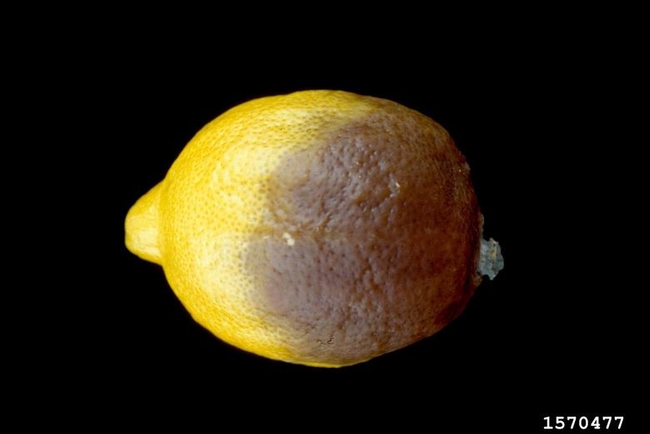
citrus brown rot lemon
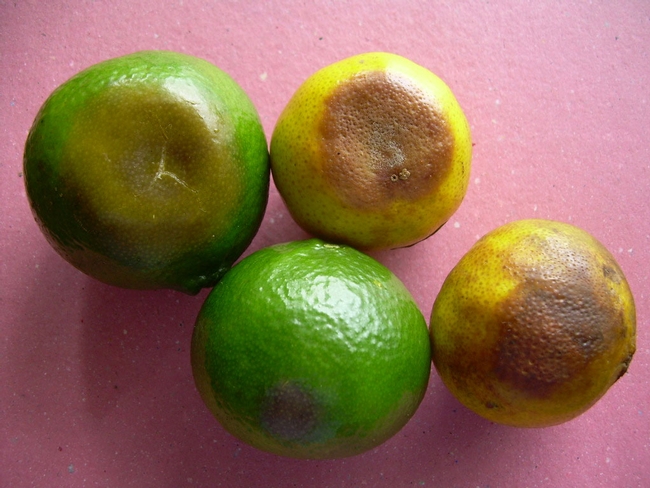
citrus brown rot mandarin
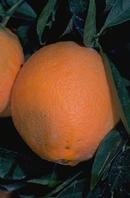
citrus brown rot orange

